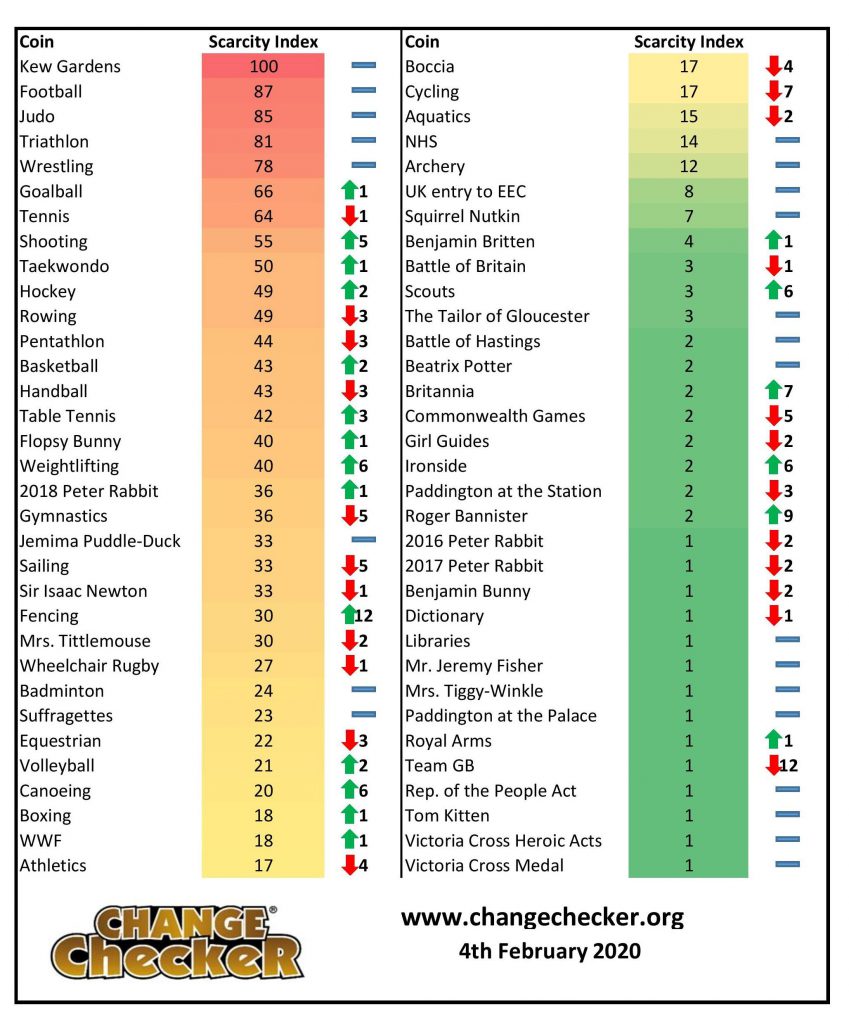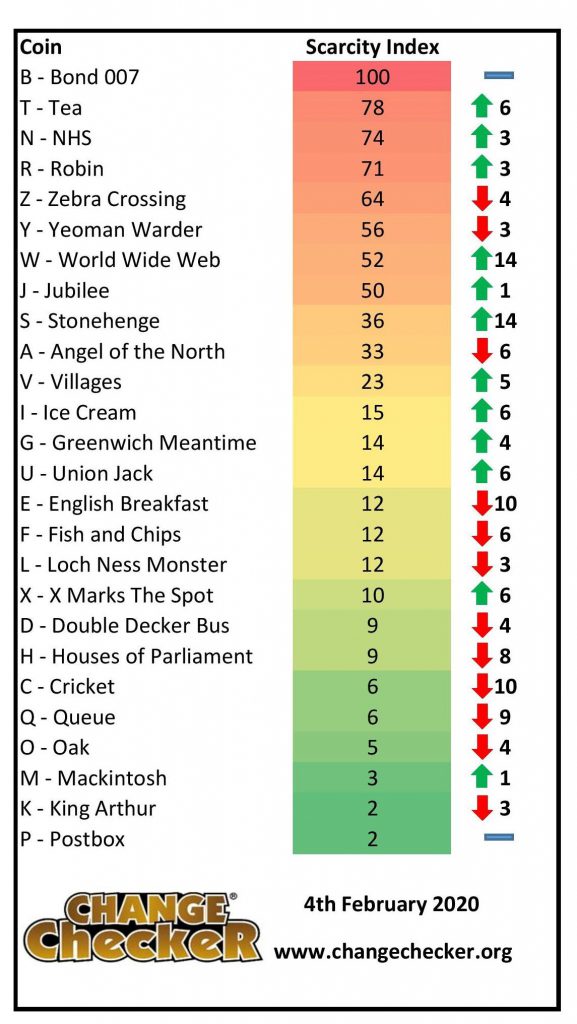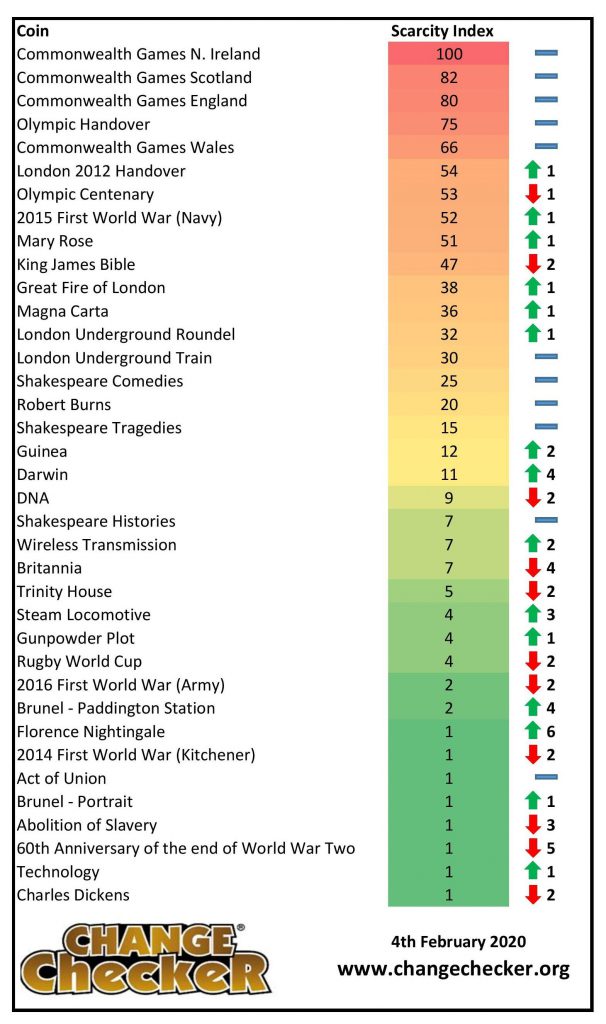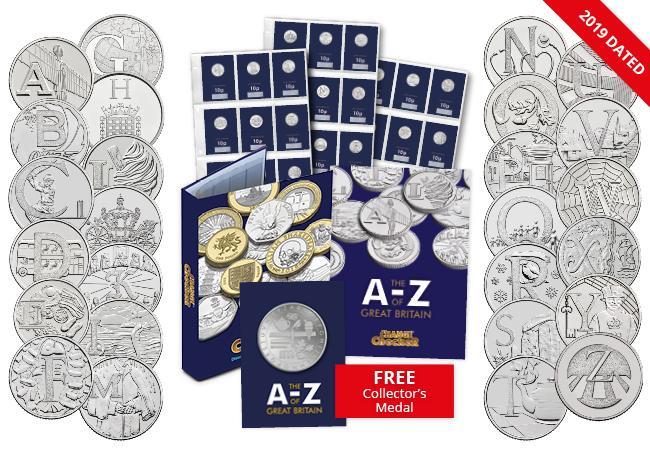Posts Tagged ‘10p’
2020 Scarcity Index Update!
We’re excited to reveal to you the very first Scarcity Index of 2020!
The updated 50p, A-Z 10p and £2 indexes below allow you to discover how sought-after the coins in your collection really are…
This information has been compiled using data from the Change Checker Swap Centre and presented in the easy to use indexes below, with arrows to signify how many places up or down a coin has moved since the last Scarcity Index.
50p Scarcity Index

The previous Scarcity Index update saw some exciting changes to the 50p index, as we were able to include the 2018 50p coins following the release of their mintage figures.
This was great news for Change Checkers who have the 2018 Beatrix Potter 50ps in their collection, as both the Flopsy Bunny and Peter Rabbit 50ps have proved incredibly sought-after.
Despite both coins having the same mintage figure of 1,400,000, the Flopsy Bunny 50p is the most sought-after of the Beatrix Potter coins and is in fact the scarcest non-Olympic 50p coin in circulation, aside from of course the Kew Gardens 50p – the UK’s most sought-after circulation 50p.
Whilst both the Flopsy Bunny and 2018 Peter Rabbit 50ps have moved up the index one place since the last update, the other 2018 50ps haven’t fared quite so well, with the Mrs Tittlemouse and Paddington at the Station both moving down the index and the other 2018 50ps remaining unchanged.
The biggest mover on this latest Scarcity Index update goes to the Olympic Fencing 50p, which has moved up the index an incredible twelve places, following its five place drop on the previous update.
As we look forward to the Olympic Games which will be held in Tokyo later this year, perhaps we’ll see more of the Olympic 50ps increase in popularity by the next Scarcity Index update.
A-Z 10p Scarcity Index

We’re used to seeing quite a bit of movement on the A-Z 10p index as these particularly tricky-to-find coins are snapped up by collectors.
Interestingly, in this latest update only the top and bottom coins have remained unchanged, with B for Bond staying on top spot as the current scarcest A-Z 10p coin in circulation.
For many, this coin seems to be a firm favourite from the A-Z of Great Britain collection which was released in 2018, so it comes as no surprise that it has found its way to the top of the list.
P for Postbox is unfortunately bottom of the pile once again, although it’s worth remembering that all of these coins are considered sought-after and collectors fortunate enough to come across just one will be considering themselves lucky.
The biggest movers on the latest 10p index update are W for World Wide Web and S for Stonehenge, which have both moved up the index by 14 places.
S for Stonehenge actually dropped by 14 places in the previous index, so this could be the coin levelling back out again.
It will be interesting to see how the index changes as more collectors come across these coins and as we await the release of the 2019 mintage figures. We currently know that 220,000 of each design entered circulation in 2018 and a further 2.1 million coins overall were released in 2019, but exact figures for individual 2019 designs are currently unknown.
£2 Scarcity Index

Following the 2018 mintage figure reveal, we know that no £2 coins have entered circulation since 2016, so the £2 index continues to remain fairly stable with no new coins to add to the mix.
The top five coins are unchanged since the last index and it comes as no surprise that the Commonwealth Games Northern Ireland £2 remains on the top spot, as this £2 has a mintage figure of just 485,500 and is considered incredibly sought-after amongst collectors.
All three Olympic themed £2 coins (Olympic Handover, Olympic Centenary and London 2012 Handover) also remain very close to the top of the index and I wonder if the Tokyo Olympics this year will affect the scarcity of these already very popular coins.
The biggest mover on the £2 index is the Florence Nightingale coin, which has moved up by six places, whilst the 60th Anniversary of World War Two coin has moved down by five places to the third from bottom space.
As I’m sure you’ll agree, it would be fantastic to see some new £2 coins entering circulation and how they might affect the £2 Scarcity Index. Fingers crossed they’ll be enough demand for these coins to enter circulation soon!
How your Scarcity Index works
Generally collectors have had to rely upon mintage figures to identify the scarcest coins. But they only tell part of the story. Trying to find a good quality coin from 15 – 20 years ago, even for a higher mintage issue, is much more challenging than a more recent issue, as coins become damaged over time and are ultimately removed from circulation.
Additionally, some designs are more hoarded than others by people who might not normally collect coins – the poignant First World War £2 Coin series being an example. Finally, it can be up to a couple of years before the Royal Mint eventually confirms the actual mintage for an issue.
That’s why we have combined the mintage information with two other key pieces of information.
- How many of each design are listed as “collected” by Change Checkers, indicating the relative ease of finding a particular coin.
- The number of times a design has been requested as a swap over the previous 3 months, showing the current level of collector demand.
Importantly, as new coins are released and popularity rises and falls across different designs the Scarcity Index will be updated quarterly allowing Change Checkers to track the relative performance of the UK’s circulation coins.
How much are my coins worth?
The Scarcity Index does not necessarily equate to value but it is certainly an effective indicator. For example, the Kew Gardens 50p coin commands a premium of up to 200 times face value on eBay.
You can use the 6 point guide to help you determine a more realistic value for your coins.
What about £1 Coins?
The £1 Scarcity Index has already been published for the Round £1 coins and, because they are no longer being issued, this is now set in stone.
If you’re interested in coin collecting, our Change Checker web app is completely free to use and allows users to:
– Find and identify the coins in their pocket
– Collect and track the coins they have
– Swap their spare coins with other Change Checkers

Sign up today at: www.changechecker.org/app
How much is an A-Z of Great Britain 10p worth now?
The A-Z of Great Britain 10p coins have been a firm favourite with collectors since they were first released last year, with 26 Quintessentially British designs capturing the public’s imagination.
Unsurprisingly, some designs are proving more popular than others, but which ones are likely to fetch the most on the secondary market?
We’ve done the hard work for you by taking a look at which A-Z 10p coins are selling for the most on eBay and which ones you should be looking out for.

The Ones to Watch…
If you’ve been lucky enough to find the ‘B’ for Bond 10p in your change, you may want to keep hold of it as it currently sells on eBay for around £3.05 – over 30 times its face value!
This coin also currently holds the top spot on our Scarcity Index, so it seems collectors everywhere are desperate to add this 10p to their collection!
In very close second, the ‘C’ for Cricket 10p sells for an average of £2.98, followed by ‘J’ for Jubilee in third, which has been selling for around £2.69.
How Many A-Z 10ps Are Out There?
Earlier this year it was confirmed that there were only 220,000 of each individual design released into circulation in 2018. We know that there were 2.1 million coins issued for 2019 but we’re yet to find out the individual mintage figures for each design.
When the official figures are released we could well see some of these coins increasing in value on the secondary market due to their low mintage!
These coins are notoriously tricky to find, but have you been lucky enough to come across any in your change? Let us know in the comments below.
Own the 2019 Complete Certified Uncirculated A-Z 10p Set
To secure the 2019 Complete Certified Uncirculated A-Z 10p Set, click here
Discovering the UK’s Definitive Coin Designs
We’re celebrating the unsung heroes of the coin collecting world by taking a deep dive into the UK’s definitive coin designs.
From the 1p to the £2 coin, find out all you need to know about the definitive coins that have been issued over the last 51 years…
£2
1997-2015: History of Technology £2

In 1997 a new type of £2 coin was introduced which featured an innovative bi-metallic design and was the first in the history of British coinage.
Previously, £2 coins had been issued as commemoratives only and featured a single metal design.
The reverse of the new bi-metallic coin shows Bruce Rushin’s representation of mankind’s technological evolution from the Iron Age. The concentric circles each denote a different technological milestone, including the Industrial Revolution, the computer age and the age of the Internet.
The obverse features a portrait of Queen Elizabeth II by Ian Rank-Broadley.
2015 – Present: Britannia £2

In 2015, the “History of Technology” design, which featured on the £2 coin since 1997, was replaced by the introduction of an iconic Britannia design by Anthony Dufort.
Britannia first appeared on British coins in 1672 and subsequently featured on a British coin in one way or another for more than 300 years. In 2008 she was surprisingly dropped from the 50 pence piece despite a Daily Mail campaign to save her, and so her appearance on the definitive £2 coins in 2015 was a triumphant return.
The obverse features Jody Clark’s portrait of Queen Elizabeth II, which is the 5th portrait of Her Majesty to appear on a coin.
So far there have only been issues of this coin in 2015 and again in 2016, however just 650,000 Britannia £2s were issued in 2015, making it the joint 3rd rarest £2 in circulation.
£1
2008-2016: Royal Arms

The first UK £1 coin was issued in 1983 to replace the £1 banknote, which was only lasting a few months in circulation.
It was struck from Nickel-brass, making it yellow in colour, and it was much thicker than the other coins in our change.
£1 coins were initially issued in recurring five year programmes including series of designs representing the UK and the home nations.
It wasn’t until 2008 that the first official definitive £1 coin was issued.
The reverse design was created by Matthew Dent, who won a public competition to redesign the UK’s definitive coinage.
His concept was based on the Royal Shield of Arms and this £1 coin features the complete shield – representing the United Kingdom as a whole.
The obverse design featured the 4th portrait of Queen Elizabeth II, by Raphael Maklouf until 2015, when this was replaced by Jody Clark’s design.
2016 – Present: Nations of the Crown

To combat counterfeiting, a new bi-metallic, 12-sided £1 coin was introduced in March 2017.
Billed as the most secure circulating coin in the world, the new £1 coin was designed by 15-year-old David Pearce following a public competition in 2015.
The new design is made up of the English rose, the Welsh leek, the Scottish thistle and the Northern Irish shamrock emerging from one stem within a royal coronet to represent the four constituent countries of the United Kingdom.
The obverse features the 5th portrait of Queen Elizabeth II by Jody Clark.
50p
1969-1981: Britannia 50 New Pence

October 1969 saw the entrance of the 50 New Pence coin into circulation and its revolutionary heptagonal shape was the first of its kind.
Its reverse design, by Christopher Ironside remained traditional however, featuring the familiar and iconic image of Britannia.
Arnold Machin’s portrait of Queen Elizabeth II features on the obverse and this was the second portrait of Her Majesty to appear on a coin.
1982-1997: Britannia 50 Pence

In 1982 the UK’s definitive coin designs were updated, as they were no longer considered ‘new’.
The lettering of this 50p differs from its predecessor, changing from ’New Pence’ to ‘Fifty Pence’.
The 1982-1997 50p features Christopher Ironside’s image of Britannia, the allegorical female figure that symbolizes Britain on the reverse.
The obverse of this coin featured the 2nd portrait of the Queen by Arnold Machin until 1985 when it was replaced with the new portrait by Raphael Maklouf.
1997-2008: Britannia Fifty Pence

In October 1994, the Government reviewed the United Kingdom coinage and a requirement for a smaller 50 pence coin was revealed.
On 1st September 1997 a 27.3mm diameter 50 pence was issued; a 2.7mm reduction from the previous 50 pence.
The traditional image of Britannia remained on the reverse, designed by Christopher Ironside, as did the obverse portrait of Queen Elizabeth II, by Raphael Maklouf.
2008 – Present: 50p Royal Arms

In 2008, the UK’s previous definitive coin designs were replaced by Matthew Dent’s winning competition entry which saw all the definitive coins form a complete image of the Royal Shield of Arms when pieced together.
The 50p coin design completes the lower section of the Royal Shield and features the denomination in the lower segment.
In 2015, the obverse design was changed to feature the 5th portrait of HM Queen Elizabeth II by Jody Clark, replacing Ian Rank-Broadley’s portrait.
This design was issued every year from 2008 to present, excluding 2009, 2010, 2011 and 2016.
The rarest Royal Shield 50p was issued in 2017 and has a mintage of 1,800,000 – making it the second rarest 50p in circulation. Mintage figures for 2018 and 2019 coins have not yet been revealed.
20p
1982-2008: The Royal Badge of England

Introduced into circulation in June 1982, the 20 pence coin was giving the same curved heptagonal shape as the 50p but is much smaller, measuring at 21.4mm in diameter.
The reverse design of the Royal Badge of England was designed by William Gardiner and it features a royally crowned double rose in between the dated year.
From 1982 the obverse features the design of Queen Elizabeth II by Arnold Machin. This changed to Raphael Maklouf’s 3rd portrait of Her Majesty Queen Elizabeth II in 1985 and Ian Rank-Broadley’s 4th portrait in 1998.
This 20p was issued annually between 1982 and 2008, excluding 1986 and 2017 in which there was low demand.
2008 – Present: 20p Royal Arms

A new design for the 20p was introduced in 2008 as part of the re-design of UK coinage using Matthew Dent’s shield design.
When the six individual coins are placed together the designs join to form the complete image of the Royal Shield of Arms. The design of the 20p shows the far-right segment of the shield.
The 20p had previously included the date on the reverse, but the new design required the Royal Mint to produce a new die with the date on the obverse. However when the new coins were struck for circulation, the old die was accidentally used, meaning a batch was issued with no date on either side of the coin, making a very rare undated 20p error coin.
The obverse features the 4th portrait of Her Majesty Queen Elizabeth II by Ian Rank-Broadley. In 2015, a 5th portrait of Her Majesty Queen Elizabeth II was designed by Jody Clark and the 20p obverse was updated to feature it.
10p
1968-1981: 10 New Pence

In 1968 the 10 New Pence coin entered circulation to replace the florin as part of Britain’s conversion to a system of decimal currency.
The public was uncertain about using this new coin to start with, after generations of pounds, shillings and pence, meaning the Decimal Currency Board still needed to reassure suspicious Britons to go decimal.
Featured on the reverse was Christopher Ironside’s design, incorporating part of the Crest of England; a lion passant guardant royally crowned.
The 2nd portrait of HM Queen Elizabeth II by Arnold Machin is on the obverse.
1992-2008: 10 Pence (3rd portrait; small type)

On 30th September 1992 a reduced size version of the 10 pence coin was introduced into circulation and the older and larger version of the coin was withdrawn from circulation on 30th June 1993.
This 10 pence measured at 24.5mm, 4mm less than its predecessor.
Whilst the reverse design by Christopher Ironside, a lion passant guardian royally crowned, remained the same, the lettering changed from ‘New Pence’ to ‘Ten Pence.’
Raphael Maklouf’s portrait of HM Queen Elizabeth II features on the obverse of the coin.
2008 – Present: 10p Royal Arms

In April 2008, Mathew Dent’s competition winning design was adopted on the 10p coin.
The 10p is designed to depict the top left quarter of the Royal Shield of Arms, showing the lions passant from the Royal Banner of England.
On the obverse, HM Queen Elizabeth II’s 4th portrait, by Ian Rank-Broadley is featured.
This 10p was issued consecutively from 2008 to 2017 but HM Queen Elizabeth II’s 5th portrait by Jody Clark, only features on coins issued after 2015.
5p
1968-1981: Five New Pence

In April 1968, 5p coins were issued as a replacement for shillings in preparation for decimalisation in 1971.
These were released into circulation at the same time as the very first 10p coins.
The reverse, by Christopher Ironside, shows The Badge of Scotland and a thistle royally crowned.
The obverse features the second crowned portrait of HM Queen Elizabeth II, designed by Arnold Machin.
1990-1998: Five Pence- Reduced Size

In 1987 the Government announced its intention to issue a smaller 5p coin and on 27th June 1990 the new 18.00mm 5p was introduced.
The reverse design remained the same as the previous years’, with a royally crowned Scottish thistle, designed by Christopher Ironside but the words ‘Five Pence’ were written instead of ‘New Pence’.
From 1990 to 1998 the obverse design shows Raphael Maklouf’s portrait of Her Majesty Queen Elizabeth II and from 1998 to 2008 the obverse design shows Ian Rank-Broadley’s portrait of Her Majesty Queen Elizabeth II.
2008 – Present: Royal Arms

A new design for the 5p was introduced in 2008 as part of the re-design of UK coinage using Matthew Dent’s Royal Shield design.
The 5p coin depicts the centre of the Royal shield, showing the meeting point of the four quarters.
The obverse from 2008 to 2015 features the 4th portrait of Her Majesty Queen Elizabeth II by Ian Rank-Broadley and from 2015 to present features the 5th portrait of Her Majesty Queen Elizabeth II by Jody Clark.
2p
1971-1981: Badge of the Prince of Wales – New Pence

On 15 February 1971, the United Kingdom adopted a new decimal currency system and the 2p was introduced into general circulation.
The reverse incorporates the wording ‘NEW’ so to avoid confusion between the old and new coinage and features the badge of the Prince of Wales, designed by Christopher Ironside.
The obverse features Arnold Machin’s portrait of HM Queen Elizabeth II; her second crowned portrait to appear on a coin.
1985-1992: Badge of the Prince of Wales – Two Pence

In 1982, the reverse inscription on the 2p coin was changed from ‘NEW PENCE’ to ‘TWO PENCE’.
The reverse of the coin features the badge of the Prince of Wales with his motto ‘Ich Dien’ (I serve), designed by Christopher Ironside.
From 1982 the obverse shows the third portrait of HM Queen Elizabeth II, by Raphael Maklouf. This changed in 1998 when it was replaced by Ian Rank-Broadley’s 4th portrait of HM Queen Elizabeth II.
Due to the increase in metal prices on world markets, in 1992 the composition of 2p coins was changed from bronze to copper-plated steel and as a result, they are magnetic.
2008 – Present: 2p Royal Arms

In 2008, the UK’s previous definitive coin designs were replaced by Matthew Dent’s winning competition entry which saw all the definitive coins form a complete image of the Royal Shield of Arms when pieced together.
The 2p coin design completes the upper-right section of the Royal Shield and features the denomination in the top segment.
From 2008 the obverse design featured the 4th portrait of HM Queen Elizabeth II by Ian Rank-Broadley. In 2015, the obverse design was changed to feature the 5th portrait of HM Queen Elizabeth II by Jody Clark.
1p
1971-1981 Portcullis and Chains: New Penny

On 15 February 1971, the United Kingdom adopted a new decimal currency system and the 1p was introduced into general circulation.
The reverse of the coin, designed by Christopher Ironside, features an adaptation of the Badge of King Henry VII and his successors; a portcullis with chains royally crowned.
To separate this coin from the previous coinage, the wording ‘NEW’ was incorporated.
The obverse shows the 2nd portrait of HM Queen Elizabeth II, by Arnold Machin.
1982- 2008: Portcullis and Chains: One Penny

The reverse inscription on the 1p coin was changed from ‘NEW PENNY’ to ‘ONE PENNY’ in 1982.
The reverse of the coin continued to feature Christopher Ironside’s portcullis with chains design.
From 1982 the obverse shows the third portrait of HM Queen Elizabeth II, by Raphael Maklouf. This changed in 1998 when it was replaced by Ian Rank-Broadley’s 4th portrait of HM Queen Elizabeth II.
Due to the increase in metal prices on world markets, in 1992 the composition of 1p coins was changed from bronze to copper-plated steel and as a result, they are magnetic.
2008 – Present: 1p Royal Arms

Matthew Dent’s new design for the 1p was introduced in 2008 to create the Royal Shield of Arms using the UK’s definitive coins.
The 1p coin depicts the left segment of the Royal shield with the denomination in the far-left.
From 2008 the obverse features the 4th portrait of Her Majesty Queen Elizabeth II by Ian Rank-Broadley. From 2015 the obverse features the 5th portrait of Her Majesty Queen Elizabeth II by Jody Clark.
½ Penny
1971-1981: St Edward’s Crown: New Penny

This Half Penny coin was introduced in February 1971, to coincide with decimalisation, and was worth 0.5 of a penny.
Continued production of the coin was necessary due to the fact that the old sixpence (with a decimal face value of 2.5p) remained in circulation until 1980.
The reverse of the coin was designed by Christopher Ironside, featuring St Edward’s Crown.
The obverse of the Half Penny remained the same throughout its short time in circulation. This featured the portrait of Queen Elizabeth II by Arnold Machin.
1982-1984: St Edward’s Crown: Half Penny

In 1982 Christopher Ironside’s reverse design of the Half Penny was updated, as the coin was no longer considered ‘New’.
The inscription at the top of the reverse design now read ‘Half Penny’.
The obverse design by Arnold Machin remained unchanged.
As Britain’s smallest decimal coin, both in size and in value, the Half Penny unfortunately found itself becoming Britain’s least favourite coin and was demonetised and withdrawn from circulation in 1984 after just 13 years in circulation.
Now that we’re more than 10 years on since the last update of the reverse of the UK’s definitive coins, perhaps we could be due for a re-design…
What do you think? Let us know in the comments below!
And next time you check your change, make sure you spare a thought for the definitive coins in your pocket and the vital role they play in Britain’s numismatic history.
Have you joined the Definitive 50p Collecting Challenge?

The race is on to find and collect the definitive 50ps in your change in time for the 50th anniversary of the 50p!






